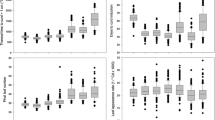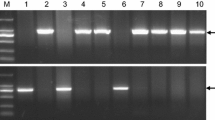Abstract
Carrots are typically classified as annual or biennial, depending on their vernalization requirement for flowering, a trait that is genetically-conditioned. Wild carrots are predominantly annual, requiring less hours of cold temperatures for flower induction, whereas most cultivated carrots are biennial (i.e., they have higher cold temperature requirements). After vernalization, if followed by long days, floral stem elongation and flowering take place. Previous studies using F2 and BC1 families derived from crosses between an early and a late-flowering line revealed segregation ratios consistent with a monogenic trait, with annual habit being dominant over biennial. In this work, we studied inheritance and segregation of the vernalization requirement in carrot F2 populations derived from crosses involving carrots of different genetic backgrounds and geographical origins. Nine crosses between biennial and annual phenotypes were analyzed, for 2 years, by means of percentage of flowering plants (parental lines, F1 and F2 families were sown in the fall for adequate discrimination between annual and biennial plants). Based on the obtained segregation ratios, a genetic model for this trait was proposed. The results are consistent with a model of two genes (Vrn-A and Vrn-B) with three alleles controlling the vernalization requirement. Dominance of annuality was clear for both genes, with A1 allele having an epistatic effect over Vrn-B. Vrn-A and Vrn-B interact generating different vernalization requirement levels.
Similar content being viewed by others
References
Abe J, Guan GP, Shimamoto Y (1997) A gene complex for annual habit in sugar beet (Beta vulgaris L.). Euphytica 94:129–135
Abegg FA (1936) A genetic factor for the annual habit in beets and linkage relationship. J Argic Res 53:493–511
Alessandro MS (2011) Estudio genético y molecular de la respuesta a la vernalización en zanahoria (Daucus carota L.). Ph.D. thesis, PROBIOL, Universidad Nacional de Cuyo, Argentina
Alessandro MS, Galmarini CR (2007) Inheritance of vernalization requirement in carrot. J Am Soc Hort Sci 132:525–529
Alessandro MS, Galmarini CR, Ali A, Simon PW (2010) Evaluation of vernalization requirement in different carrot populations. 34 International Carrot Conference, EEUU
Alessandro MS, Galmarini CR, Iorizzo M, Simon PW (2013) Molecular mapping of vernalization requirement and fertility restoration genes in carrot. Theor Appl Genet 126:415–423
Amasino RM (2004) Vernalization, competence and the epigenetic memory of winter. Plant Cell 16:2553–2559
Atherton JG, Basher EA, Brewster JL (1984) The effects of photoperiod on flowering in carrot. J Hort Sci 59:213–215
Atherton JG, Craigon J, Basher EA (1990) Flowering and bolting in carrot. I. Juvenility, cardinal temperatures and thermal times for vernalization. J Hort Sci 65:423–429
Caicedo AL, Stinchcombe JR, Olsen KM, Schmitt J, Purugganan MD (2004) Epistatic interaction between Arabidopsis FRI and FLC flowering time genes generates a latitudinal cline in a life history trait. Proc Natl Acad Sci 101:15670–15675
Camargo LEA, Osborn TC (1996) Mapping loci controlling flowering time in Brassica oleracea. Theor Appl Genet 92:610–616
Dias Tagliacozzo GM, Válio IFM (1994) Effect of vernalization on flowering of Daucus carota (Cvs Nantes and Brasilia). Rev Bras de Fisiol Veg 6:71–73
Dickson MH (1958) The physiology and inheritance of flowering in carrots. Ph.D. thesis, Department of Horticulture, Michigan State University of Agriculture and Applied Science
Galmarini CR, Della Gaspera P (1996) Determinación de requerimientos de prevernalización en zanahorias (Daucus carota L.) anuales. Actas de la XXI Reun Argent de Fisiol Veg: 82. Mendoza
Galmarini CR, Borgo R, Tizio R (1992) Determination of a prevernalization phase in carrot (Daucus carota L.) cv. Flakkee Turrialba 42:140–142
Gendall AR, Levy YY, Wilson A, Dean C (2001) The Vernalization 2 gene mediates the epigenetic regulation of vernalization in Arabidopsis. Cell 107:525–535
Hiller LK, Kelly WC (1979) The effect of post-vernalization temperature on seedstalk elongation and flowering in carrots. J Am Soc Hort Sci 104:253–257
Iorizzo M, Senalik DA, Ellison SL, Grzebelus D, Cavagnaro PF, Allender C, Brunet J, Spooner DM, Van Deynze A, Simon PW (2013) Genetic structure and domestication of carrot (Daucus carota subsp. sativus) (Apiaceae). Am J Bot 100:930–938
Iorizzo M, Ellison S, Senalik D, Zeng P, Satapoomin P, Huang J, Bowman M, Iovene M, Sanseverino W, Cavagnaro P, Yildiz M, Macko-Podgórnil A, Moranska E, Grzebelus D, Ashrafi H, Zheng Z, Cheng S, Spooner D, Van Deynze A, Simon P (2016) A high-quality carrot genome assembly provides new insights into carotenoid accumulation and asterid genome evolution. Nature Genet 48:657
Lang A (1986) Hyoscyamus niger. In: Halevy AH, Boca Raton FL (eds) CRC handbook of flowering, 144–186
Levy YY, Mesnage S, Mylne JS, Gendall AR, Dean C (2002) Multiple roles of Arabidopsis VRN1 in vernalization and flowering time control. Science 297:243–246
Li F, Sun J, Wang D, Bai S, Clarke AK, Holm M (2014) The B-box family gene STO (BBX24) in Arabidopsis thaliana regulates flowering time in different pathways. PLoS ONE 9:e87544
Michaels SD, Amasino RM (2000) Memories of winter: vernalization and the competence to flower. Plant Cell Environ 23:1145–1153
Ou CG, Mao JH, Liu LJ, Li CJ, Ren HF, Zhao ZW, Zhuang FY (2017) Characterizing genes associated with flowering time in carrot (Daucus carota L.) using transcriptome analysis. Plant Biol 19:286–297
Reeves PA, He Y, Schmitz RJ, Amasino RM, Panella LW, Richards CM (2007) Evolutionary conservation of the FLOWERING LOCUS C–mediated vernalization response: evidence from the sugar beet (Beta vulgaris). Genetics 176:295–307
Rubatzky VE, Quiros CF, Simon PW (1999) Carrots and related vegetable umbelliferae. CABI Publ, New York
Searle I, He Y, Turck F, Vincent C, Fornara F, Kröber S, Amasino RA, Coupland G (2006) The transcription factor FLC confers a flowering response to vernalization by repressing meristem competence and systemic signaling in Arabidopsis. Gene Dev 20:898–912
Sung S, Schmitz RJ, Amasino RM (2006) A PHD finger protein involved in both the vernalization and photoperiod pathways in Arabidopsis. Gene Dev 20:3244–3248
Taiz L, Zeiger E (2002) Plant physiology. 3rd edn. Sinauer Associates, Sunderland
Tranquilli G, Dubcovsky J (2000) Epistatic interaction between vernalization genes Vrn-Am 1 and Vrn-Am2 in Triticum monococcum. J Hered 91:304–306
Trevaskis B, Bagnall DJ, Ellis MH, Peacock WJ, Dennis ES (2003) MADS box genes control vernalization-induced flowering in cereals. Proc Natl Acad Sci 100:13099–13104
Van Deynze A, Peter Pauls K (1994) The inheritance of seed colour and vernalization requirement in Brassica napus using double haploid populations. Euphytica 74:77–83
Whitaker TW, Sherf AF, Lange WH, Nicklow CW, Radewald JD (1970) Carrot production in the United States. Agriculture Handbook No. 375, Agricultural Research Service, US Department of Agriculture, Washington, DC
Wijnheijmer EHM, Brandenburg WA, Ter Borg SJ (1989) Interactions between wild and cultivated carrots (Daucus carota L.) in the Netherlands. Euphytica 40:147–154
Zhang XK, Xiao YG, Zhang Y, Xia XC, Dubcovsky J, He ZH (2008) Allelic variation at the vernalization genes Vrn-A1, Vrn-B1, Vrn-D1, and Vrn-B3 in Chinese wheat cultivars and their association with growth habit. Crop Sci 48:458–470
Acknowledgements
This work was funded by Argentine National Agency for Scientific and Technological Promotion through grant ‘PICT-2014-1245’, and by the National Vegetable, Flower and Aromatics Program of INTA, Argentina. The authors acknowledge Dr. Philipp Simon for providing germplasm of some of the lines included in the study, and Dr. Pablo Diego Asprelli for fruitful discussions on the segregation analysis.
Author information
Authors and Affiliations
Corresponding author
Additional information
Publisher's Note
Springer Nature remains neutral with regard to jurisdictional claims in published maps and institutional affiliations.
Electronic supplementary material
Below is the link to the electronic supplementary material.
Rights and permissions
About this article
Cite this article
Wohlfeiler, J., Alessandro, M.S., Cavagnaro, P.F. et al. Multiallelic digenic control of vernalization requirement in carrot (Daucus carota L.). Euphytica 215, 37 (2019). https://doi.org/10.1007/s10681-019-2360-2
Received:
Accepted:
Published:
DOI: https://doi.org/10.1007/s10681-019-2360-2




